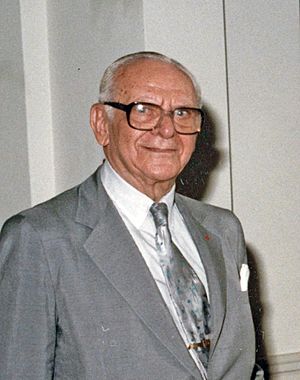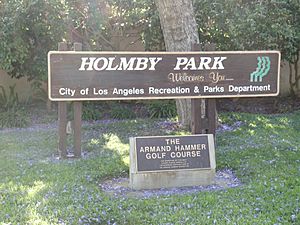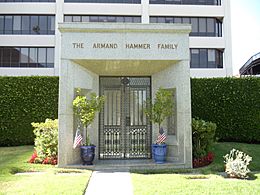Armand Hammer facts for kids
Quick facts for kids
Armand Hammer
|
|
|---|---|

Hammer in 1982
|
|
| Born | May 21, 1898 New York City, U.S.
|
| Died | December 10, 1990 (aged 92) Los Angeles, California, U.S.
|
| Alma mater | Columbia University (B.A., 1919; M.D., 1921) |
| Occupation | Business magnate |
| Known for | Occidental Petroleum |
| Spouse(s) |
Olga Vadina von Root
(m. 1927; div. 1943)Angela Carey Zevely
(div. 1954)Frances Barrett Tolman
(m. 1956; |
| Children | Julian Armand Hammer |
| Relatives |
|
Armand Hammer (May 21, 1898 – December 10, 1990) was an American businessman. He was best known for leading Occidental Petroleum, a large company, from 1957 until he passed away. People sometimes called him "Lenin's chosen capitalist" because of his strong connections to the Soviet Union.
Hammer was also famous for his amazing art collection. His business dealings and efforts to promote peace around the world helped him make many friends and connections.
Contents
Early Life and Family
Armand Hammer was born in New York City. His parents, Rose and Julius Hammer, were Jewish immigrants from the Russian Empire. His father, Julius, came to the United States from Odessa (which is now in Ukraine) in 1875. He worked as a doctor and owned several drugstores in the Bronx.
After the Russian Revolution of 1917, Julius Hammer became a key figure in forming the Communist Party USA. This group supported Vladimir Lenin and the Bolsheviks in Russia. Julius Hammer worked to build trade between the United States and Soviet Russia.
His Name and Family Business
Armand Hammer once said he was named after a character in a famous novel. However, he later confirmed that his name came from the "arm and hammer" symbol of a socialist political party his father was involved with.
When his father faced legal trouble and was imprisoned, Armand and his brother took over the family business, Allied Drug. They became very successful by buying equipment cheaply after World War I and reselling it. Armand Hammer said his first big business success was in 1919, making and selling a ginger extract.
Journey to the Soviet Union
In 1921, while his father was in prison, Armand Hammer traveled to the Soviet Union. He was only 23 years old and couldn't speak Russian. He went to manage the family's business interests there. He traveled between the Soviet Union and the United States for the next 10 years.
Even though he had studied medicine and earned a medical degree from Columbia University in 1921, his business career took off instead. He always liked being called "Dr. Hammer." The U.S. government watched him closely during his travels and for the rest of his life.
Business Ventures and Global Connections
After finishing medical school, Hammer expanded his business by importing goods from and exporting medicines to the new Soviet Union. He made his first trip to Soviet Russia in July 1921. He claimed that he brought $60,000 worth of medical supplies to help with a typhus outbreak. He also made a deal with Vladimir Lenin to trade furs, caviar, and jewelry from Russia for American wheat.
Hammer moved to the USSR in the 1920s to manage his businesses, especially a large factory that made pens and pencils. He stayed in the Soviet Union until 1930.
Art Collection and Philanthropy
When he returned to the United States, Hammer received some Fabergé eggs from the Soviets. He and his brother, Victor, owned the "Hammer Galleries" in New York City. Armand Hammer's personal art collection, which includes many famous Impressionist paintings, is now the main part of the Hammer Museum at UCLA in Los Angeles, California.
Hammer was also a generous philanthropist. He supported many causes, including education, medicine, and the arts. One of his important contributions was helping to establish the Armand Hammer United World College of the American West, which is now called UWC-USA. He also supported Jewish charities, especially those related to the the Holocaust.
Occidental Petroleum and International Relations
In 1956, Hammer gained control of Occidental Petroleum (Oxy). Through this company, he played a big role in changing how oil prices were set globally. He helped give OPEC (Organization of the Petroleum Exporting Countries) more control over oil prices.
Throughout his life, he continued to do business and maintain personal connections with the Soviet Union, even during the Cold War. He worked hard to promote peace between the United States and Communist countries. He even flew doctors and supplies to the Soviet Union to help people affected by the Chernobyl disaster. Historian Daniel Yergin wrote that Hammer became a link between five Soviet leaders and seven U.S. Presidents.
Supporting the Gore Family
Armand Hammer had a close friendship with Al Gore Sr., who was a U.S. Senator. Gore Sr. later became the head of a coal company that was part of Occidental Petroleum. Hammer was also very fond of Al Gore Jr., Al Gore Sr.'s son, who later became Vice President of the United States. Hammer encouraged and supported Al Gore Jr.'s political career.
Arm & Hammer Brand
In the 1980s, Armand Hammer owned a lot of stock in Church & Dwight, the company that makes Arm & Hammer products. He was also on their board of directors. However, the Arm & Hammer brand name was created long before Armand Hammer was born. He often joked about the coincidence and had even tried to buy the brand because people always asked him about it.
President's Cancer Panel
In 1981, President Ronald Reagan appointed Hammer to the three-member President's Cancer Panel. He later served as the chairman of this panel from 1984 to 1989. As chairman, he announced a plan to raise $1 billion each year to fight cancer.
Other Activities
Armand Hammer was nominated for the Nobel Peace Prize many times, but he never won. In 1986, Forbes magazine estimated his wealth at $200 million.
He even made a guest appearance on a 1988 episode of The Cosby Show. He played the grandfather of a friend who had cancer and spoke about a cure being close.
Hammer was also close to Charles III, who was then the Prince of Wales. He gave a lot of financial support to Prince Charles's projects and let him use his private jet.
Awards and Recognition
Armand Hammer received many awards during his lifetime. In 1978, he was given the Soviet Union's Order of Friendship of Peoples by Leonid Brezhnev. This award recognized his strong support for international worker movements and the needs of the Soviet Union.
Other awards he received include:
- Golden Plate Award of the American Academy of Achievement (1978)
- US: National Medal of Arts (1987)
- France: Legion of Honor
- Italy: Grand Officer of the Order of Merit of the Italian Republic (1981)
- Sweden: Royal Order of the Polar Star
- Austria: Knight Commander's Cross
- Pakistan: Hilal-i-Quaid-Azam Peace Award
- Israel: Leadership Award
- Venezuela: Order of Andrés Bello
- Mexico: National Recognition Award
- Bulgaria: Jubilee Medal
- Belgium: Order of the Crown
- John Jay Award (1981) from Columbia College, his university
Personal Life
Armand Hammer was the middle of three sons. He had close relationships and worked in business with his brothers, Harry and Victor, throughout their lives.
He was married three times. His first marriage was in 1927 to Olga Vadimovna von Root, a Russian actress. In 1943, he married Angela Zevely. In 1956, he married Frances Barrett, a wealthy widow, and they were married until she passed away in 1989.
Armand Hammer had one child, a son named Julian Armand Hammer, with his first wife. His grandson is businessman Michael Armand Hammer, and his great-grandson is actor Armie Hammer.
Armand Hammer passed away in December 1990 at the age of 92 in Los Angeles. He was buried in Westwood Village Memorial Park Cemetery.
Images for kids
See also
- Cyrus Eaton
- List of people pardoned or granted clemency by the president of the United States






